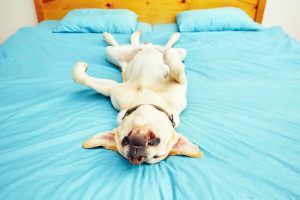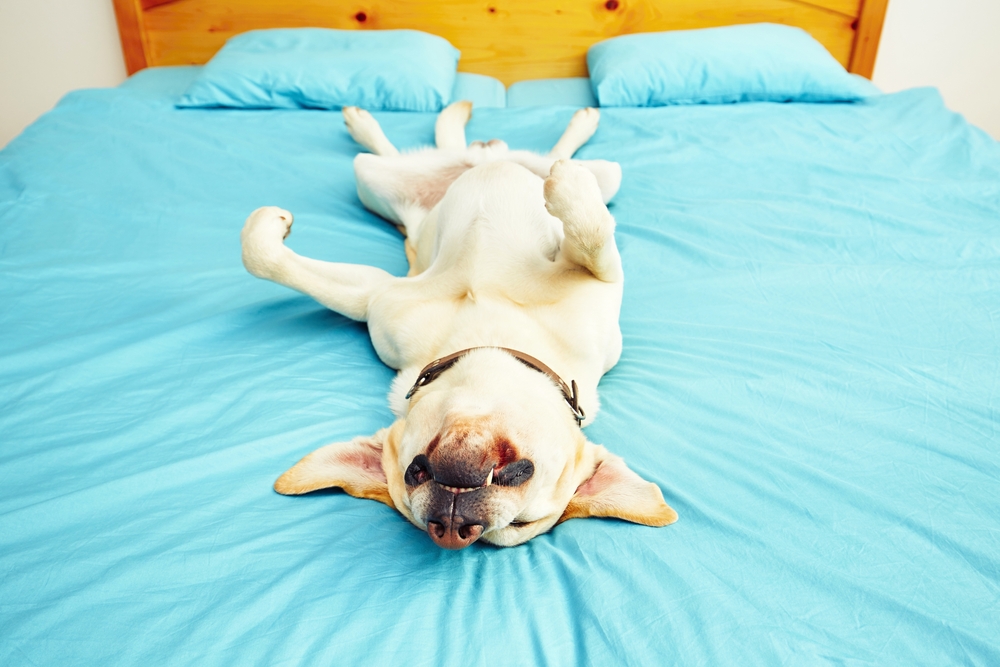Thinking of welcoming a bouncy, boisterous, and beautiful Labrador Retriever into your home? Aside from their exercise needs, food preferences, and whether your future doggo will prefer belly rubs or head pats, you might be thinking about their Lab coat. Nope, we’re not talking about the white, protective variety, but your Labrador’s grooming requirements. Do you need to brush them daily, weekly, monthly, or practically never? How often do you need to bathe them? And do Labradors shed excessively, or will your home remain forever fur-free?
To help you figure out a game plan for your new furbaby, or if you’re just a lucky Labrador-Owner and you’re wondering how to manage Labrador shedding, we’ve put together some handy tips.

Do Labradors shed?
They certainly do! In fact, Labradors are notorious shedders. The reason why Labs shed is all to do with their working past.
Originally, Labradors were bred as working dogs. True to the ‘Retriever’ part of their name, their main responsibilities involved sniffing out and retrieving birds that their Owner had shot. They also assisted with various duties on-board fishing boats. Through lots of time spent outdoors, Labradors developed a special coat that protected them from the cold.
This special coat is known as a double coat, and it’s a feature that Labradors have maintained to this day. The outer layer is coarse and waterproof, while the inner layer is dense, fluffy, and super cosy. The inner layer, known as the undercoat, keeps Labradors warm – especially when swimming in cold water or during rainfall.
In short, because Labradors (and other double-coated dog breeds) have this thick undercoat, they need to get rid of it from time to time to adapt to the changing seasons. This is why Labradors shed so much.
When and how much do Labradors shed?
If you were hoping for an occasional shedder, well, we’re not going to sugarcoat it: Labradors pretty much shed year-round. You’ll definitely notice a decent amount of hair around your home, on the couch, in your car, and basically wherever else your Lab goes.
Luckily, ongoing shedding is quite manageable. It’s when Labs are in the thick of moulting season (also known as shedding season) that things can get a little hairy, so to speak.
Labradors shed their undercoat twice a year – this is commonly known as “blowing coat”. They shed in spring so they can get rid of their dense winter coat and grow a lighter one ahead of summer. They also shed in autumn so they can replace their thin summer coat with a snug winter one. Each shedding season lasts around two to three weeks.
During moulting season, Labradors shed a lot. You’ll probably be cleaning up after your Lab much more when this happens, perhaps even daily.
It’s also worth noting that there’s no difference between Chocolate Labs, Yellow Labs, and Black Labs. While the amount of shedding can vary between individual dogs, each coat colour tends to shed equally.
Do they shed more than other dogs?
So if they indeed are big shedders, do Labradors shed more than other breeds? Compared to some, yes, absolutely. Compared to others, the amount of shedding is pretty on par.
Generally speaking, dog breeds which shed most have double coats, just like Labs. Not only do double-coated dogs shed year-round, but they also blow their coats up to several times a year to make way for a new coat.
Single-coated dog breeds shed throughout the year, too, but they don’t need to get rid of their coat during moulting season. In saying that, don’t be fooled into thinking all single-coated breeds are light shedders! Some single-coated dogs can still shed quite a bit.
Dog breeds that can shed a lot include:
- German Shepherds (double-coated)
- Golden Retrievers (double-coated)
- Huskies (double-coated)
- Malamutes (double-coated)
- Australian Shepherds (double-coated)
- Rough and Smooth Border Collies (double-coated)
- Shetland Sheepdogs (double-coated)
- Rottweilers (double-coated)
- Cardigan Welsh and Pembroke Welsh Corgis (double-coated)
- Pomeranians (double-coated)
- Chow Chows (double-coated)
- Basset Hounds (single-coated)
- Dalmatians (single-coated)
- Fawn Pugs (double-coated)
- Jack Russells (double-coated)
Dogs breeds that shed less include:
- Greyhounds
- Afghan Hounds
- Bichon Frises
- Poodles
- Schnauzers
- Maltese Terriers
- Yorkshire Terriers
- Silky Terriers
- Shih Tzus
- Labradoodles (yep, breeding a Lab with a Poodle cuts the shedding right down!)
How can I manage Labrador shedding?
Heart still set on a Lab and happy to deal with year-round shedding and twice-yearly blowouts? Here are our tips to help you handle the hair.
Groom them on the regular
Regular brushing is key when it comes to managing your Lab’s shedding. This is because it allows you to remove loose hairs in a single grooming session, rather than having them (liberally) sprinkled all over your house. Throughout the year, you can brush them once or twice per week. While they’re in moulting season, though, you’ll want to increase brushing to four times a week, or even daily.
If your doggo isn’t used to being brushed, or simply doesn’t like it, you can start slow. Begin with a couple of brush strokes and build your way up to a full grooming session. You may also find it easier to brush your Lab while they’re distracted, such as when they’re chowing down on their favourite meal. Or, you can use bits of quality dry dog food as treats to incentivise them!
Level up your deshedding tool kit
Anyone with a high-shedding pooch knows you need an arsenal of tools to keep your dog and home clean. There are specialised deshedding tools and brushes made for dogs with double coats, which are super handy when it comes to grooming.
As for keeping your home fur-free, sometimes a classic vacuum cleaner stands no chance against a shedding Lab. You could opt for a vacuum cleaner designed to collect animal hair, or another tool like a handheld hair remover.
Keep them out of hair’s reach
Dog hair is pretty much unavoidable if you own a Lab. But, you can try and restrict where it ends up. If you’d prefer not to wake up to a hair nest, you might want to avoid letting your Labrador sleep in your bed. If there’s a particular room you like to reserve for guests, you could keep your dog in other parts of your home. And if your car is starting to resemble an unkempt grooming salon, you could protect your seats with a special seat cover.
Enlist an expert
Labs need a lot of grooming, so from time to time it certainly doesn’t hurt to call in an expert. A groomer can give them a good wash and brush to help with shedding, and even offer bonus services like nail cutting. There are trusted Dog Grooming Services nationwide, so you’re very likely to find one near you.
Whatever you do, don’t shave!
It might seem obvious to simply shave off your Lab’s fur to stop shedding, but this is a big no-no. A Lab’s coat has evolved to perfectly protect their skin and body. So, getting rid of it puts them at risk of dry skin, sunburn, and excess moisture or dirt. Shaving can also mess with their natural temperature control. And lastly, it does practically nothing to curb shedding. Instead, they’ll just shed their regrowth, which can actually be more of a pain to clean up.

